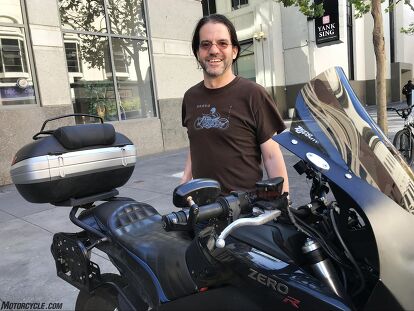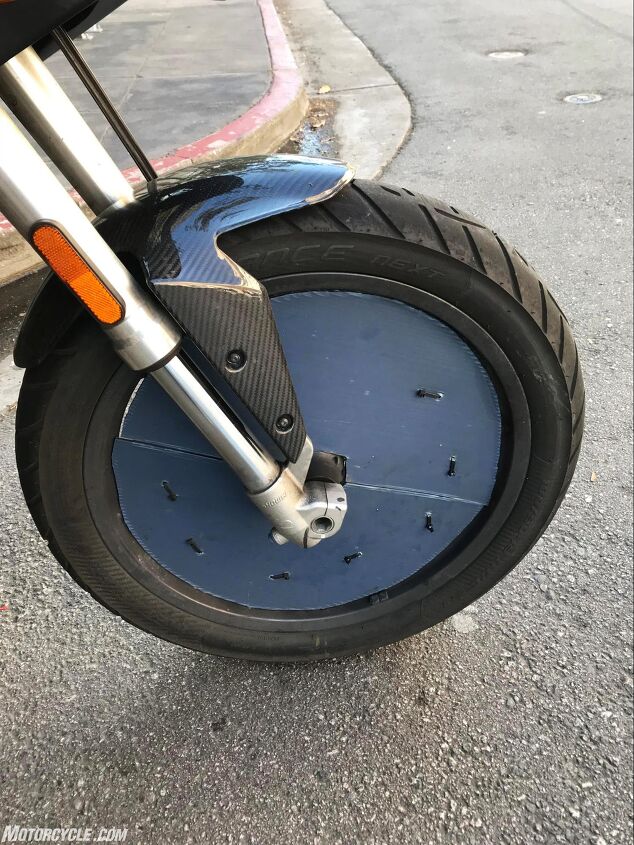Skidmarks: Touring on an Electric Moto
How far do you really need to go?
We’ve been force-feeding you an awful lot of electric-motorcycle content lately, but here’s something that’s been tugging at my mind for years. We know E-motos are good at racing, commuting and supermoto fundays, but their range – hovering around the 100-mile mark – is what’s limiting them from being truly all-around products.
Or is it?
The last time you went on a long motorcycle trip, did you just, as the Aerostich T-shirt says, ride, eat, sleep, repeat? Sometimes that is the case, but when riding the long way with a group of friends, the norm is 80-120 mile stints interrupted by maddeningly slow, frequent gas and rest stops.
You know how it is: the more people you ride with, the longer it takes to get everybody gassed up, rested, snacked, potty-breaked and smart-phone checked. And then there’s always one guy with his helmet and gloves off, chewing on an energy bar while everybody else are on their bikes, waiting at the gas station driveway, turn signals blinking hopefully. Come on, man! The bar closes at 9:00 in some of these little towns.
So as long as there are places you can charge your bike in 30 or 40 minutes every 100 miles, in theory you should be able to have a similarly dysfunctional (with emphasis on the fun) touring experience on an electric moto. That was the thought I was mulling over, but writing a whole column about that seemed like a lot of work… until yesterday.
There I was, column due the next day and Brasfield breathing down my neck (not really), and I had no idea what to write about. Luckily, Fate has a way of dumping things into your lap. As I dropped off a Lyft passenger in front of his hotel near the San Francisco Embarcadero, I spied a weird-looking motorcycle parked against a curb across the street, surrounded by tools and luggage. God, why are you so kind to us agnostics?
Serious, thin, pony-tailed and bespectacled, the 2016 Zero DSR‘s owner was as quirky and unexpected in appearance as his fully-electric steed. Turns out Brian Rice was on his way back from hiking in Marin county when his drive belt decided it had finally had enough after 30,000 miles. He found a convenient place to park and went home to get a spare belt, tools and a jack to get his bike back on the road. Unfortunately, he didn’t pack an Allen-head socket beefy enough to unscrew his swingarm, which is where I came in. For the trouble of schlepping our electric road-warrior back home to get the right tool I could get his story. Not a bad deal.
As I drove him first to his pad, then to the auto-parts store to get a new socket, he told me about his experience building a tourer out of a short-range commuter. Turns out, if there’s a guy anywhere purpose-built to pursue such a project, it’s Brian.
“I grew up in Houston around NASA engineers,” the 30-ish Rice told me. His father worked in CAD software sales, so naturally the younger Rice was “into super-nerdy stuff… Dick Rutan was a hero.” He dropped out of studying engineering at Texas A&M, opting for hands-on experience as a Navy electrical technician. He wound up in the nuclear powerplant of the megacarrier USS Carl Vinson.
“A lot of that stuff carried over into electric motorcycles. I know enough to avoid accidents where the power vaporizes a screwdriver and then you breathe in the metal vapor,” which he says is really a Thing That Happens, yet another reason to avoid the U.S. Navy. So when Rice acquired his Zero DSR, it wasn’t long before he started to modify it to suit his needs.
Electric motorcycle touring is also a Thing, a pretty well-established one in fact. We’ve reported on Zero hero Terry “Electric Terry” Hershner, a man who has garnered his own Wikipedia listing by being the first person to ride an electric motorcycle cross-country (in 2014), even though I totally thought about doing it first. Terry’s approach seems to be three-pronged: increase battery capacity, increase aerodynamic efficiency, and decrease charging time by adding chargers.
Of these three things, it would seem you’d get the easiest gains by simply adding bigger batteries, but you’d be wrong. Batteries are heavy, expensive and complicated to plumb into the electrical system. Adding a 3.3 kilowatt-hour “Power Tank” to a Zero S or DS nets you a 25% bump in capacity (and range), but also puts over 45 pounds right on top of the bike and digs a $2,895 hole in your wallet, too. Terry boosted his bike’s capacity to over 22 kWh, more than double the stock bike. He also doubled the weight of the stock bike. Brian bought a powertank, but it sounds like the biggest gains are elsewhere.
Using his mad electrical skills, Brian replaced the standard on-board charger (which squeezes out just 1.3 kWh and takes 10 hours to charge his bike) with not one but three 3.5 kWh DigiNow chargers. That’s over 10 kWh of charging capability, and you don’t even need a DC fast charger to utilize it: just plug two standard Level-2 chargers (the kind you find at most public charging stations) into the bike: he’s installed two ports just for that reason, one on top and one on the side.
I wonder if he was thinking about that vaporized screwdriver the first time he fired it all up?
Now he has a bike that can charge from fully dead to just about topped off in 90 minutes, or as former Maximum MOron Sean Alexander would call it, five minutes. But in most cases, Brian charges from low double digits to somewhere in the 80s or low 90%, and that takes a lot less time; the last 10% can take 30 minutes or more as the system slows the juice down to balance out the cells. Most of Brian’s breaks are 30 minutes or less, sometimes not even enough time for a relaxed lunch. Trips from San Francisco to Los Angeles (my personal touring-day benchmark) are doable in eight hours or so, and he’s made it to Seattle from the Bay (800 miles) in just two days. And Iron Butts? Electric Terry did his first 1000-mile day all the way back in 2014.
But maybe the biggest hurdle is that soft stuff you’re surrounded by every day: the air. At 40 or 50 mph it doesn’t do much, but go over 60 and we all know it can start to really sap efficiency, especially on a naked bike like the DSR. Terry’s bike has gotten the full Craig Vetter treatment, and now the egg-shaped thing, equipped with more battery capacity than a Nissan Leaf, can go over 300 miles on a charge. Brian went the dustbin-fairing route as well.
However, he wasn’t happy with the limited steering lock, size or the unsexy appearance of riding what looks like Flipper with wheels. He’s installed a much smaller Hollywood Electrics-designed fairing, and it looks darn sporty. Oh, and it still gives him a 25-30 percent bump in range over naked. With 16 kWh of battery, he can go 135 miles at highway speeds. I don’t know about you, but that’s usually more than I like to ride without a break.
Brian sometimes prefers the convenience of occasionally riding his other bike, a Suzuki V-Strom 650, but seems to prefer the novelty and adventurous spirit of electric touring. “It’s a lot of work, but it’s very enjoyable in a different way from a gas bike. You’re going to hear the birds chirp in the forest. There’s something very compelling about it.”
If you’re not as impressed by Terry and Brian’s engineering efforts as I am, I understand. But think how much more a big factory like Honda or BMW, with their armies of engineers, wind tunnels and millions of dollars could do. In fact, the technology exists now for a Goldwing-sized touring rig with enough battery capacity and efficiency to go 300 miles or more on a charge. Using DC fast-charge technology (or dual level-2), there’s no reason why such a rig shouldn’t charge back up to 95% in under 30 minutes. Using ultra-frugal parts sourcing (Zero seems to excel at this), the MSRP should be about what you’d pay for a comparable gasoline moto from BMW, Harley-Davidson or Honda.
Holy crap, the future is just around the corner, and guys like Terry and Brian are helping us get there. Check out Brian’s most-informative Zero motorcycle Wiki, ZeroManual.com, if you crave more detailed info about modifying Zero motorcycles for long-distance riding.
Gabe Ets-Hokin would like to point out that he is cited as a primary source seventeen times on Wikipedia and yet there is no listing for him, which he sees as a massive injustice. “I am doomed to anonymity, thanks to the MSM’s totally unfair obsession with people who actually do noteworthy things,” he whines.
More by Gabe Ets-Hokin








































Comments
Join the conversation
If a manufacturer came out with an electric bike with a 300 mile range around 500 lbs., I'd open my wallet.
Charging time and durability are still my biggest concerns. My stock 2015 12.5 S has less than 10,000km on it and a charge from 25% to full can now take more than 48 hrs (it use to take 12-14). that last 5% can now take a whole day (and sometimes will only come up to 98% no matter how long i leave it) I skipped the power tank for the aforementioned price and weight issues. perhaps i'll stop riding and take up baby making (if my old batteries will take it)